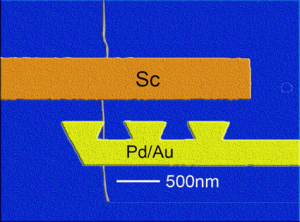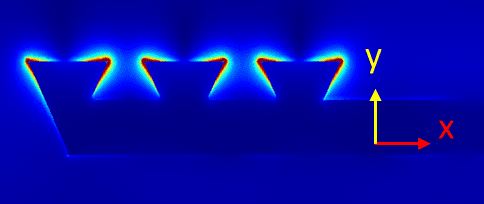Carbon nanotubes (CNTs) are nowadays used in various applications and have long entered the world of photodetection. These materials exhibit outstanding optical and electrical properties including strong and broadband infrared absorption, and high electron and hole mobility. In contrast to traditional infrared photodetector materials, such as HgCdTe and InGaAs, carbon nanotubes can absorb incident light efficiently even if the CNT film is only a few tens of nanometers thick. However, a drawback of the one-dimensional material is that the photoresponse is weak for incident light with polarization perpendicular to the nanotubes.

False-colored SEM picture showing a barrier-free bipolar diode device with an axe-like plasmonic structure
To improve their CNT infrared photodetector a group of researchers with Lian-Mao Peng and Sheng Wang (Peking University) have made use of the plasmonic effects. Plasmon resonances usually represent collective oscillation of conduction electrons at a metallic interface or in small metallic structures induced by incident light. In the presented device an axe-like plasmonic contact electrode leads to a stronger field near the electrode, and efficient collection of carriers. The photocurrent can be enhanced nearly 200 times compared to a device without plasmonic structure. Particularly, the researchers were able to show an explicit photocurrent enhancement when the polarization of incident light is perpendicular to the carbon nanotubes. The effect is dependent on the position of the carbon nanotubes with respect to the axe-like structure. An even larger enhancement can be achieved by further tuning the gate voltage. The full study which is also evidenced by simulations of the electric field has been published in Advanced Optical Materials.
It is envisioned that such plasmonic electrodes could be used to tune the response of devices under perpendicular polarization, which may be useful for optical interconnection on chips.

















